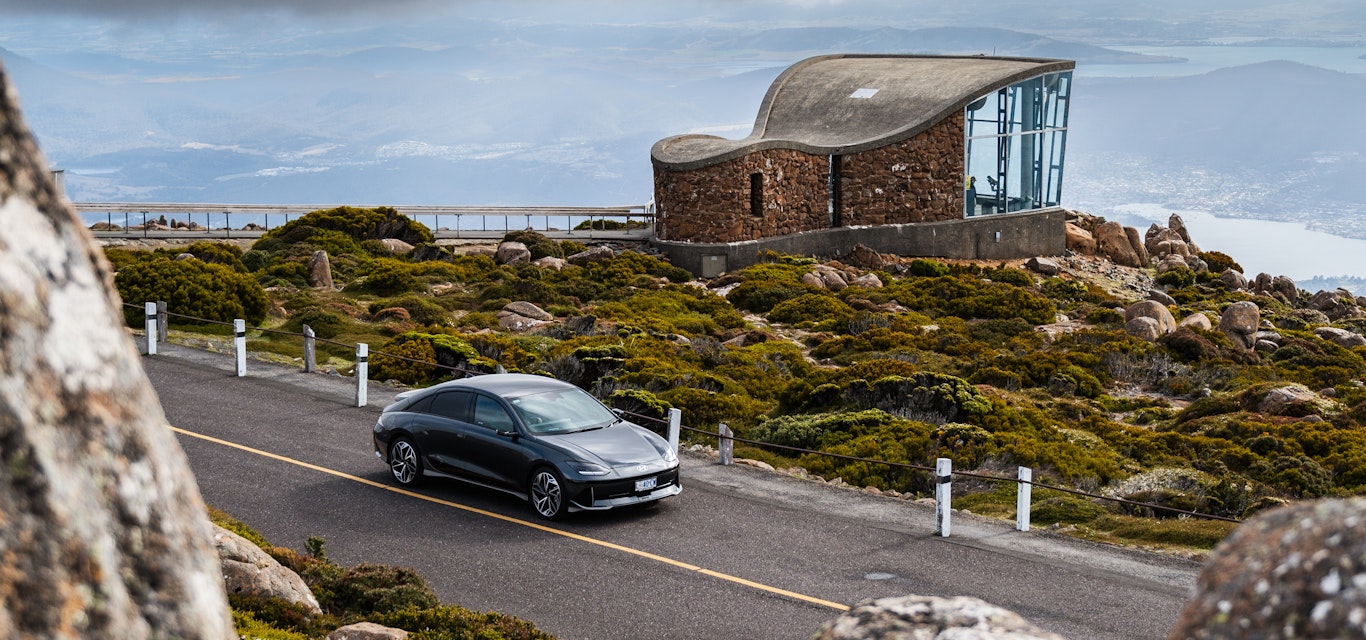Road test: Hyundai IONIQ 6
It feels like the future has arrived when behind the wheel of the all-electric IONIQ 6. Andrew Bain takes Hyundai’s latest EV for a spin around Hobart.
At an electric vehicle charging station on Hobart’s docks, I’ve drawn a small crowd.
Passers-by pause, as do the owners of another EV on charge, curious about the Hyundai IONIQ 6 I’ve just reversed into the space.
The car’s slick, streamlined shape is drawing admiration, though the most quizzical glances settle on the side mirrors, which aren’t mirrors at all. Instead, two cameras hang from the side of the sedan, projecting rear-view images onto wings that protrude from the dashboard. As I set out driving from the docks, these projected road scenes feel a little like having a pair of tiny Jeffrey Smart paintings hanging on my dash.
It’s my first drive of an EV and it seems a well-chosen introduction, with the IONIQ 6 named as the World Car of the Year in 2023, an award judged by more than 100 motoring journalists from 35 countries. In the same awards, it also picked up Design of the Year in a nod to the very aesthetics that are proving so eye-catching at the charging station.
From the docks, my day in the IONIQ 6 will take me through Hobart and ultimately to the top of Kunanyi/Mt Wellington, a meandering sea-to-summit spin through the city and onto the open mountain slopes.
Credit: Stu Gibson
Credit: Stu Gibson
Credit: Stu Gibson
I turn south first, wriggling through the streets of Battery Point, where the IONIQ 6 is a technological counterpoint to the lines of historic Georgian cottages. The vehicle’s interior is a classically futuristic EV cocoon of leather upholstery, air-conditioning inside the front seats to cool your back, and a dashboard with twin 12.3-inch screens – one for infotainment and the other a digital instrument cluster.
Then there are those digital mirrors that headline the IONIQ 6’s gadgetry, though they only come in the top-of-the-range EPIQ model.
The cheaper TECHNIQ and DYNAMIQ have standard side mirrors, leaving the dashboard mirror extensions hanging wide and empty like a cormorant’s drying wings.
"From Battery Point, I weave a street-art trail through the city...ascending mural by mural from the waterfront."
From Battery Point, I weave a street-art trail through North Hobart, the city and South Hobart, ascending mural by mural from the waterfront. Among the most compelling – and just the spot for my morning coffee and a gathering of sweet baked goods to fuel my wanderings on the mountain’s trails – is at South Hobart cafe Bear With Me, its side wall covered by a 10-metre-long platypus in celebration of the nearby Hobart Rivulet’s most famous resident.
One of the most noticeable features of the IONIQ 6 in this urban environment is that blind spots are a thing of the past. Each time I indicate, a blind-spot camera pops up like a spy-hole on the cluster screen, while a windscreen hologram also notes any vehicles hiding in my blind spot.
Through the morning traffic, the IONIQ 6 travels easily, but its happy place is when we tackle the more open road of the climb.
Credit: Stu Gibson
Credit: Stu Gibson
Past the almost Gothic sandstone facade of Cascades Brewery – a building that turns 200 this year – the drive becomes a fun spin on mountain roads, the car gliding around bends as though on rails and punching like a boxer when I slip the drive into sport mode.
As I rise up Pinnacle Road, cyclists whirr down from their morning climbs, and the car is as silent as the forest that encases it, at least when it’s not beeping and binging a host of warnings – nagging noises that would be the IONIQ 6’s greatest annoyance, along with a lack of headroom in the back seats.
Inside, it’s lit for fun, with a choice between 64 colours of lighting. I choose green in keeping with the bush-covered slopes of Kunanyi/Mt Wellington. Pair it with the IONIQ 6’s Sounds of Nature setting, playing a soundtrack of anything from the murmur of a forest to a crackling fireplace, and you’ve got a self-contained ecosystem.
Picking up a second coffee at the Lost Freight shipping-container cafe at The Springs, I continue winding up the slopes to Big Bend, where I park the car and set out on foot on the Lost World Track. Scrambling over boulders across the slopes of the secondary Mt Arthur, the track is a short portal into the Jenga-like puzzle of cliffs and fallen dolerite columns that is the Lost World, a scaled-down version of the Organ Pipes.
Finally, the summit beckons. Winds rake across the alpine tops of the mountain and cloud skims low overhead – a classic Kunanyi day – but the IONIQ 6 barely seems to feel the gusts, with the sleek, low design providing an aerodynamic profile that’s inspired by the curve of an aeroplane wing and the shape of a diving peregrine falcon.
Credit: Stu Gibson
Credit: Stu Gibson
High above the city, I reach my goal and wander out onto Kunanyi/Mt Wellington’s summit boardwalks, from where Hobart looks painted into the landscape below. The climb has been fun in this smooth and sassy vehicle, but I suspect the drive back down will be even better.
The specs
Pricing: from $78,825 (EPIQ $95,666)
Body style: Sedan
Seating: 5
Battery: 77.4kWh lithium-ion
Electric range: 519km
Charging time: 18 minutes from 10-80% charged
Max power: 293kW
Max torque: 605Nm
0-100km/h: 5.1 seconds
Safety: 5-star ANCAP rating (tested 2022)
